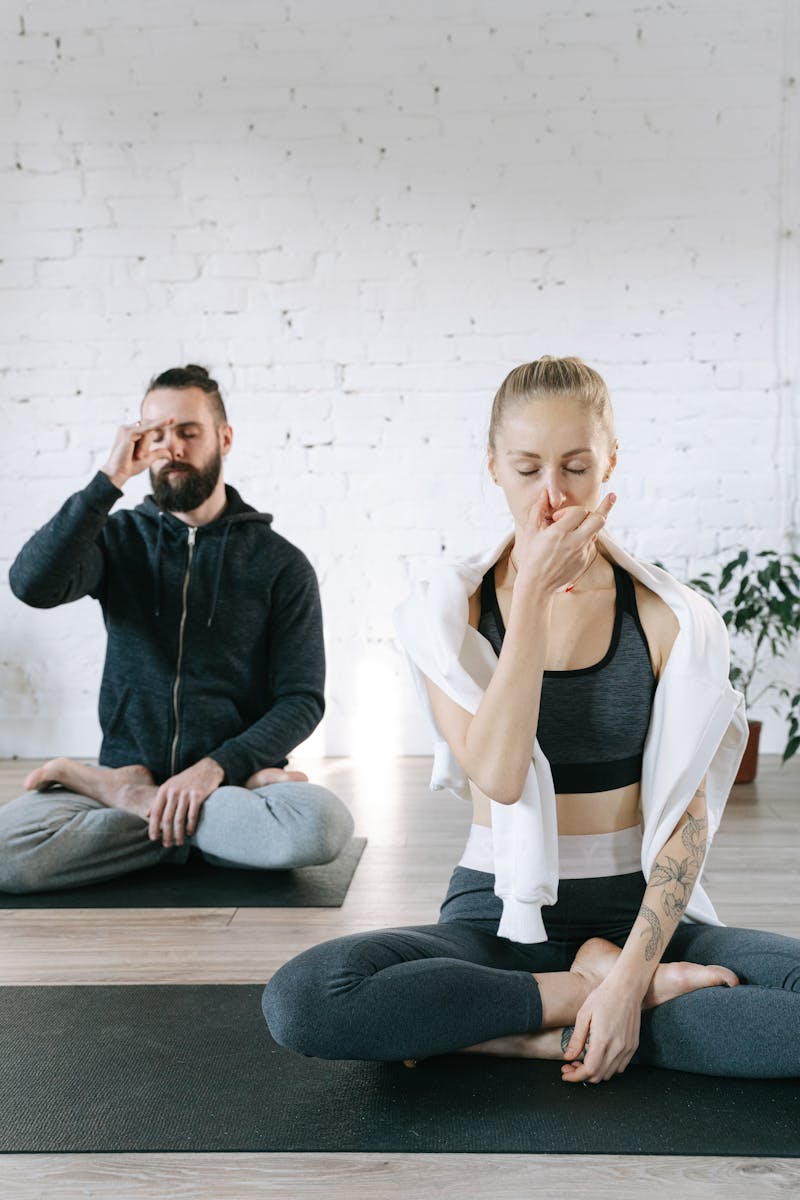
Conscious breathing known as mindful or deep breathing, is a powerful technique that can help reduce stress, improve focus, and promote a sense of calm. You may barely think about it, but it’s ever-present. Arguably, it’s one of the most important biological processes: It’s your breath. These breaths are unconscious for many, but it’s possible to harness your breath to become more aware of your body, your state of mind, and the present moment.
What is conscious breathing?
Conscious breathing generally describes the act of developing a soft awareness of your breath as it moves in and out of your body. This practice can help you achieve a state of calm and presence so you can engage more deeply with life. Conscious breathing can also help you navigate difficult thoughts, emotions, and experiences, creating the space to respond with intention and objectivity.
In yoga philosophy, the breath serves as both the vehicle and the measuring stick for the practice of awareness. It can guide you to a deeper connection with your body, mind, and the world around you. Traditional yogic wisdom holds that it’s physiologically impossible to be in a state of distress when the breath is smooth, calm, and regulated.

Conscious breathing benefits
Here are some of the key benefits:
- Stress Reduction:
- Conscious breathing activates the relaxation response, which helps reduce the production of stress hormones like cortisol. This, in turn, lowers overall stress levels and promotes a sense of calm.
- Anxiety Management:
- Mindful breathing can be an effective tool for managing anxiety. Focusing on the breath helps redirect your attention away from anxious thoughts, promoting a more grounded and centered mindset.
- Improved Focus and Concentration:
- Deep, intentional breathing increases oxygen flow to the brain, enhancing cognitive function and concentration. It can help you stay more focused and alert, especially during periods of intense work or study.
- Emotional Regulation:
- Conscious breathing allows you to observe and regulate your emotions more effectively. It can be a helpful practice in times of emotional distress, helping you respond to situations with greater emotional intelligence.
- Enhanced Sleep Quality:
- Incorporating conscious breathing into your bedtime routine can promote relaxation and improve the quality of your sleep. Deep, slow breaths signal to your body that it’s time to unwind and prepare for rest.
- Reduced Muscle Tension:
- Mindful breathing encourages the release of tension in the muscles, particularly in areas like the neck, shoulders, and jaw. This can be especially beneficial for those who experience stress-related muscle tightness.
- Lowered Blood Pressure:
- Deep breathing exercises have been shown to contribute to lower blood pressure by promoting relaxation and improving blood circulation.
- Enhanced Respiratory Function:
- Conscious breathing helps increase lung capacity and improve respiratory function. This can be particularly beneficial for individuals with respiratory conditions such as asthma.
- Mind-Body Connection:
- Practicing conscious breathing fosters a deeper connection between the mind and body. It encourages you to be present in the moment, fostering a greater sense of mindfulness.
- Improved Digestion:
- Deep breathing can stimulate the parasympathetic nervous system, promoting relaxation and aiding in digestion. It may help alleviate symptoms of indigestion and contribute to overall gut health.
- Coping with Pain:
- Mindful breathing can be used as a complementary technique for managing pain. By focusing on the breath, individuals may experience a reduction in the perception of pain.
- Enhanced Mood:
- Regular conscious breathing practices have been linked to improved mood and a greater sense of well-being. The calming effect on the nervous system can contribute to an overall positive outlook.
How to practice conscious breathing –
Practicing conscious breathing, also known as mindful or deep breathing, is a simple yet effective technique that can be done almost anywhere and at any time. Here’s a step-by-step guide on how to practice conscious breathing:
- Find a Comfortable Position:
- Sit or lie down in a comfortable position. If sitting, ensure your back is straight, and your shoulders are relaxed. You can also practice conscious breathing while standing.
- Relax Your Body:
- Close your eyes if you’re comfortable doing so. Relax your facial muscles, shoulders, and any tension in your body. Allow your hands to rest comfortably on your lap.
- Focus on Your Breath:
- Direct your attention to your breath. Observe the natural rhythm of your breathing without trying to change it. Notice the sensation of the breath as it enters and leaves your body.
- Inhale Slowly and Deeply:
- Inhale slowly and deeply through your nose. Feel the air filling your lungs, and let your abdomen expand as you breathe in. Aim for a full, deep breath.
- Pause at the Top of the Breath:
- At the top of your inhale, gently pause for a moment. Feel the stillness at the peak of your breath.
- Exhale Slowly and Completely:
- Exhale slowly and completely through your mouth or nose. Feel the release of tension as you exhale. Focus on the sensation of letting go.
- Pause at the Bottom of the Breath:
- At the end of your exhale, pause for another moment before inhaling again. Embrace the stillness at the bottom of your breath.
- Repeat the Cycle:
- Continue this cycle of deep inhalation, a brief pause, slow exhalation, and another brief pause. Allow each breath to be deliberate and unhurried. Maintain a steady and comfortable rhythm.
- Focus Your Mind:
- If your mind starts to wander, gently bring your focus back to the sensation of breathing. You can also use a specific focus point, such as the rise and fall of your chest or the feeling of air passing through your nostrils.
- Set a Duration:
- Start with a few minutes, and gradually extend the duration as you become more comfortable with the practice. You can set a timer or simply practice for as long as feels right for you.
- Incorporate Throughout the Day:
- Integrate conscious breathing into your daily routine. You can practice it in the morning, during breaks, or before bedtime to promote relaxation and mindfulness.
- Explore Different Techniques:
- Experiment with various breathing techniques, such as diaphragmatic breathing, box breathing, or alternate nostril breathing, to discover what resonates best with you.
Top Conscious Breathing Techniques for Stress Relief and More
1. Pursed lip breathing
This simple Conscious breathing technique makes you slow down your breathing pace by having you deliberate effort in each breath. You can practice pursed lip breathing at any time. It may be especially useful during activities such as bending, lifting, or stair climbing.
To do it:
- Relax your neck and shoulders.
- Keeping your mouth closed, inhale slowly through your nose for 2 counts.
- Pucker or pursed your lips as though you were going to whistle.
- Exhale slowly by blowing air through your pursed lips for a count of 4.
2. Diaphragmatic breathing
Diaphragmatic Conscious breathing (aka belly breathing) can help you use your diaphragm properly. It may also help reduce stress and help with challenges related to eating disorders, constipation, high blood pressure, migraine episodes, and other health conditions.
When you begin, you may feel tired, but over time the technique should become easier and should feel more natural.
- Lie on your back with your knees slightly bent and your head on a pillow.
- You may place a pillow under your knees for support.
- Place one hand on your upper chest and one hand below your rib cage, allowing you to feel the movement of your diaphragm.
- Slowly inhale through your nose, feeling your stomach pressing into your hand.
- Keep your other hand as still as possible.
- Exhale using pursed lips as you tighten your abdominal muscles, keeping your upper hand completely still.
You can place a book on your abdomen to make the exercise more difficult. Once you learn how to do belly breathing lying down, you can increase the difficulty by trying it while sitting in a chair. You can then practice the technique while performing your daily activities.
3. Breath focus technique
This deep Conscious breathing technique uses imagery or focus words and phrases. You can choose a focus word that makes you smile, feel relaxed, or is simply neutral. As you build up your breath focus practice, you can start with a 10-minute session. Gradually increase the duration until your sessions are at least 20 minutes.
To do it:
- Sit or lie down in a comfortable place.
- Bring your awareness to your breaths without trying to change how you’re breathing.
- Alternate between normal and deep breaths a few times. Notice any differences between normal breathing and deep breathing. Notice how your abdomen expands with deep inhalations.
- Note how shallow breathing feels compared to deep breathing.
- Practice your deep breathing for a few minutes.
- Place one hand below your belly button, keeping your belly relaxed, and notice how it rises with each inhale and falls with each exhale.
- Let out a loud sigh with each exhale.
- Begin the practice of breath focus by combining this deep breathing with imagery and a focus word or phrase that will support relaxation.
- You can imagine that the air you inhale brings waves of peace and calm throughout your body. Mentally say, “Inhaling peace and calm.”
- Imagine that the air you exhale washes away tension and anxiety. You can say to yourself, “Exhaling tension and anxiety.”
4. Lion’s breath
Lion’s breath is an energizing yoga breathing practice that is said to relieve tension in your chest and face. It’s also known in yoga as Lion’s Pose or Simhasana in Sanskrit.
To do this:
- Come into a comfortable seated position. You can sit back on your heels or cross your legs.
- Press your palms against your knees with your fingers spread wide.
- Inhale deeply through your nose and open your eyes wide.
- At the same time, open your mouth wide and stick out your tongue, bringing the tip down toward your chin.
- Contract the muscles at the front of your throat as you exhale out through your mouth by making a long “ha” sound.
- You can turn your gaze to look at the space between your eyebrows or the tip of your nose.
- Do this breath 2 to 3 times.
5. Alternate nostril breathing
Alternate nostril breathing, known as Nadi Shodhana Pranayama in Sanskrit, is a breathing practice for relaxation. It has been shown to enhance cardiovascular function and lower heart rate. Keep your breath smooth and even throughout the practice.
To do this:
- Choose a comfortable seated position.
- Lift your right hand toward your nose, pressing your first and middle fingers down toward your palm and leaving your other fingers extended.
- After an exhale, use your right thumb to gently close your right nostril.
- Inhale through your left nostril and then close your left nostril with your right pinky and ring fingers.
- Release your thumb and exhale out through your right nostril.
- Inhale through your right nostril and then close this nostril.
- Release your fingers to open your left nostril and exhale through this side.
- This is one cycle.
- Continue this breathing pattern for up to 5 minutes.
- Finish your session with an exhale on the left side.
6. Equal breathing
Equal breathing is known as Sama Vritti in Sanskrit. This breathing technique focuses on making your inhales and exhales the same length. Making your breath smooth and steady can help bring about balance and equanimity. Research on older adults with high blood pressure showed that this technique may help improve mental well-being and increase the oxygen supply to the brain and lungs.
You should find a breath length that is not too easy and not too difficult. You also don’t want it to be too fast to maintain it throughout the practice. Usually, this is between 3 and 5 counts. Once you get used to equal breathing while seated, you can do it during your yoga practice or other daily activities.
To do it:
- Choose a comfortable seated position.
- Breathe in and out through your nose.
- Count during each inhale and exhale to make sure they are even in duration. Alternatively, choose a word or short phrase to repeat during each inhale and exhale.
- You can add a slight pause for breath retention after each inhale and exhale if you feel comfortable. (Normal breathing involves a natural pause.)
- Continue practicing this breath for at least 5 minutes.
7. Resonant or coherent breathing
Resonant breathing, also known as coherent breathing, is when you breathe at a rate of 5 full breaths per minute. You can achieve this rate by inhaling and exhaling for a count of 5.
To do this:
- Inhale for a count of 5.
- Exhale for a count of 5.
- Continue this breathing pattern for at least a few minutes.
8. Sitali breath
This yoga breathing practice helps you lower your body temperature and relax your mind. Slightly extend your breath in length but don’t force it. Since you inhale through your mouth during Sitali breath, you may want to choose a place to practice that’s free of any allergens that affect you and air pollution.
To do this:
- Choose a comfortable seated position.
- Stick out your tongue and curl your tongue to bring the outer edges together.
- If your tongue doesn’t do this, you can purse your lips.
- Inhale through your mouth.
- Exhale out through your nose.
- Continue breathing like this for up to 5 minutes.
9. Deep breathing
Deep Conscious breathing helps to relieve shortness of breath by preventing air from getting trapped in your lungs and helping you to breathe in fresher air. It may help you to feel more relaxed and centered.
To do this:
- While standing or sitting, draw your elbows back slightly to allow your chest to expand.
- Take a deep inhalation through your nose.
- Retain your breath for a count of 5.
- Slowly release your breath by exhaling through your nose.
10. Humming bee breath
This yoga-conscious breathing practice’s unique sensation helps create instant calm and is especially soothing around your forehead. Some people use humming bee breath to relieve frustration, anxiety, and anger. Of course, you’ll want to practice it in a place where you’re free to make a humming sound.
To do this:
- Choose a comfortable seated position.
- Close your eyes and relax your face.
- Place your first fingers on the tragus cartilage that partially covers your ear canal.
- Inhale and gently press your fingers into the cartilage as you exhale.
- Keeping your mouth closed, make a loud humming sound.
- Continue for as long as is comfortable.
FAQ:
Is it good to consciously breathe?
Conscious breathing techniques, such as mindfulness meditation, have been shown to improve focus and concentration. Paying attention to our breath helps calm the mind and reduce distracting thoughts, increasing productivity.
How do you take a conscious breath?
Sit comfortably and raise your ribcage to expand your chest. Place one hand on your chest and the other on your abdomen. Notice how your upper chest and abdomen move while you breathe. Concentrate on your breath and try to breathe in and out gently through the nose.
Incorporating conscious breathing into your daily routine doesn’t require much time or effort, yet the benefits can be profound. Whether you practice for just a few minutes each day or during moments of stress, cultivating mindful breathing can contribute to a healthier and more balanced life.



































